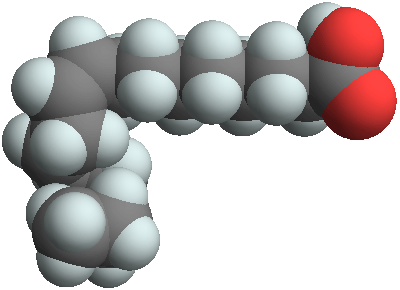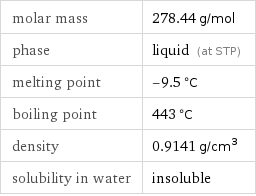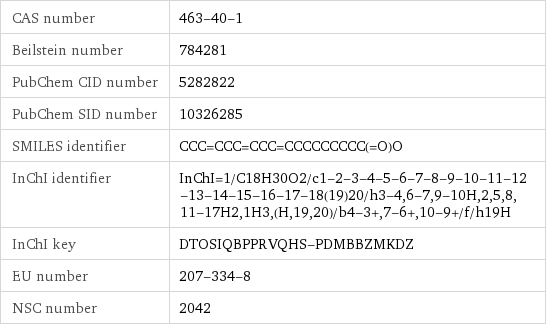Input interpretation

linolenic acid
Chemical names and formulas

formula | C_18H_30O_2 name | linolenic acid IUPAC name | (9E, 12E, 15E)-octadeca-9, 12, 15-trienoic acid alternate names | alpha-linolenic acid | cis, cis, cis-9, 12, 15-octadecatrienoic acid | (Z, Z, Z)-9, 12, 15-octadecatrienoic acid mass fractions | C (carbon) 77.6% | H (hydrogen) 10.9% | O (oxygen) 11.5%
Lewis structure

Draw the Lewis structure of linolenic acid. Start by drawing the overall structure of the molecule, ignoring potential double and triple bonds: Count the total valence electrons of the carbon (n_C, val = 4), hydrogen (n_H, val = 1), and oxygen (n_O, val = 6) atoms: 18 n_C, val + 30 n_H, val + 2 n_O, val = 114 Calculate the number of electrons needed to completely fill the valence shells for carbon (n_C, full = 8), hydrogen (n_H, full = 2), and oxygen (n_O, full = 8): 18 n_C, full + 30 n_H, full + 2 n_O, full = 220 Subtracting these two numbers shows that 220 - 114 = 106 bonding electrons are needed. Each bond has two electrons, so in addition to the 49 bonds already present in the diagram add 4 bonds. To minimize formal charge carbon wants 4 bonds and oxygen wants 2 bonds. Identify the atoms that want additional bonds and the number of electrons remaining on each atom: Fill in the 4 bonds by pairing electrons between adjacent highlighted atoms: Answer: | |
3D structure

3D structure
Basic properties

molar mass | 278.44 g/mol phase | liquid (at STP) melting point | -9.5 °C boiling point | 443 °C density | 0.9141 g/cm^3 solubility in water | insoluble
Units

Hydrophobicity and permeability properties

experimental LogP hydrophobicity | 5.8 predicted LogP hydrophobicity | 6.62 predicted LogS | -6.02
Basic drug properties

approval status | approved | nutraceutical | small molecule drug categories | dietary supplement | micronutrient
Liquid properties (at STP)

density | 0.9141 g/cm^3 vapor pressure | 4×10^-9 mmHg (at 25 °C) refractive index | 1.48
Units

Thermodynamic properties

molar heat of vaporization | 76.9 kJ/mol specific heat of vaporization | 0.276 kJ/g (at STP)
Chemical identifiers

CAS number | 463-40-1 Beilstein number | 784281 PubChem CID number | 5282822 PubChem SID number | 10326285 SMILES identifier | CCC=CCC=CCC=CCCCCCCCC(=O)O InChI identifier | InChI=1/C18H30O2/c1-2-3-4-5-6-7-8-9-10-11-12-13-14-15-16-17-18(19)20/h3-4, 6-7, 9-10H, 2, 5, 8, 11-17H2, 1H3, (H, 19, 20)/b4-3+, 7-6+, 10-9+/f/h19H InChI key | DTOSIQBPPRVQHS-PDMBBZMKDZ EU number | 207-334-8 NSC number | 2042
Safety properties

flash point | 276 °C